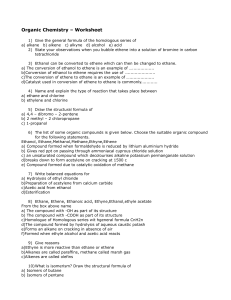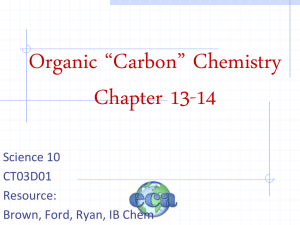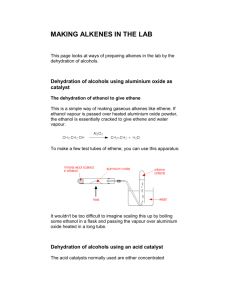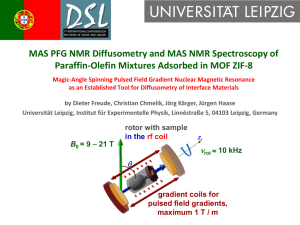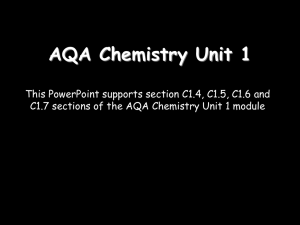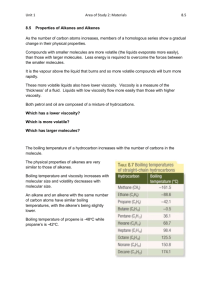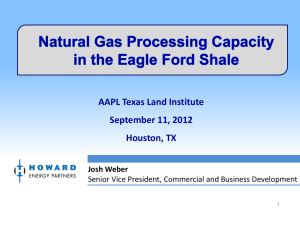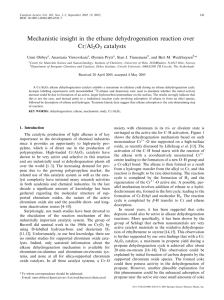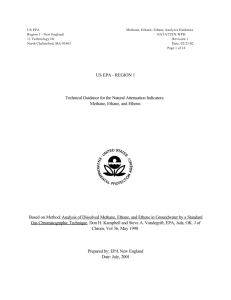Organic Chemistry (Solved)
advertisement
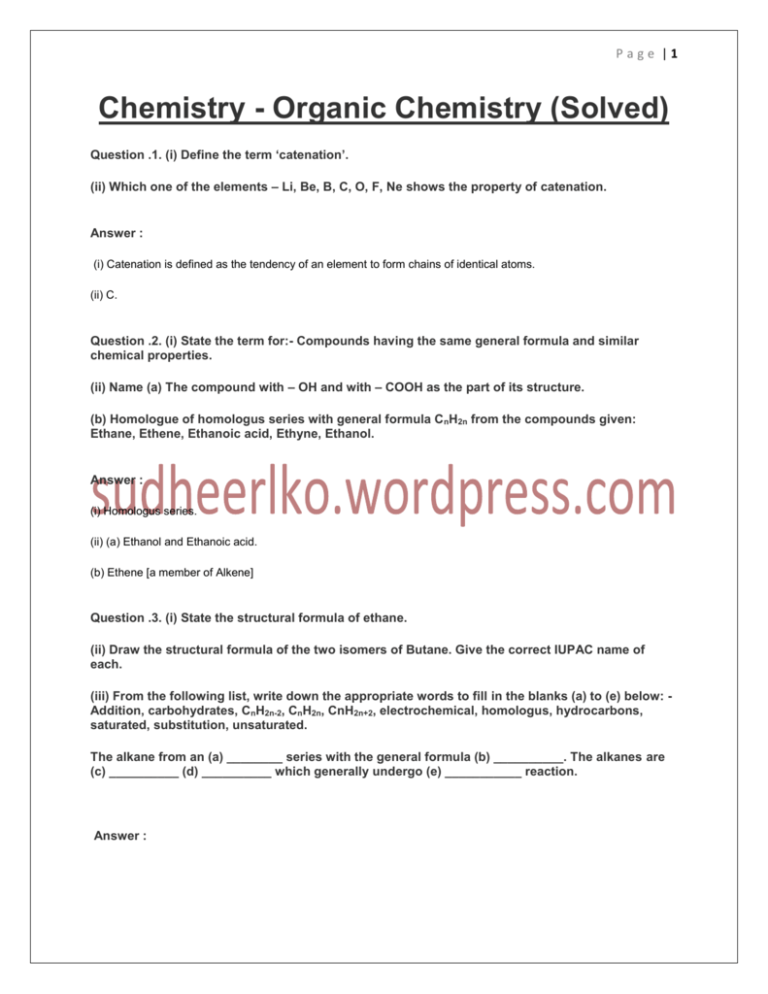
Page |1 Chemistry - Organic Chemistry (Solved) Question .1. (i) Define the term ‘catenation’. (ii) Which one of the elements – Li, Be, B, C, O, F, Ne shows the property of catenation. Answer : (i) Catenation is defined as the tendency of an element to form chains of identical atoms. (ii) C. Question .2. (i) State the term for:- Compounds having the same general formula and similar chemical properties. (ii) Name (a) The compound with – OH and with – COOH as the part of its structure. (b) Homologue of homologus series with general formula C nH2n from the compounds given: Ethane, Ethene, Ethanoic acid, Ethyne, Ethanol. Answer : (i) Homologus series. (ii) (a) Ethanol and Ethanoic acid. (b) Ethene [a member of Alkene] Question .3. (i) State the structural formula of ethane. (ii) Draw the structural formula of the two isomers of Butane. Give the correct IUPAC name of each. (iii) From the following list, write down the appropriate words to fill in the blanks (a) to (e) below: Addition, carbohydrates, CnH2n-2, CnH2n, CnH2n+2, electrochemical, homologus, hydrocarbons, saturated, substitution, unsaturated. The alkane from an (a) ________ series with the general formula (b) __________. The alkanes are (c) __________ (d) __________ which generally undergo (e) ___________ reaction. Answer : Page |2 (iii) (a) Homologus (b) CnH2n+2 (c) Sturated (d) Hydrocarbon (e) Subs Question .4. (i) For each of the compounds (a) Ethane, (b) Vinegar [acetic acid] and (iii) Marsh gas [methane], draw the relevant structural formula. What word is used to describe the above three compounds taken together? Page |3 (ii) Draw the structural formula of ethane. What is the feature of the ethane structure which allows ethane to react with chlorine in the way it does. (iii) Give the correct IUPAC name and the functional group for each of the compounds whose structural formulae are given below: (a) (b) Answer : (i) (a) Ethane is C2H6 and its structure formula is (b) Vinegar is CH3COOH (Acetic acid) and its structure formula is (c) Marsh gas is CH4 (Methane) and its structure formula is Page |4 These three compounds are called organic compound. (ii) Unsaturated Hydrocarbon with double bond. (iii) (a) IUPAC name → Propanal, Functional group → – CHO. (b) IUPAC name → Propanol, Functional group → – OH. Question .5. (i) What is the special feature of the structure of : (a) C 2H4 (b) C2H2. (ii) What type of reaction is common to both these compounds? (iii) Give the name and structural formula of (a) a saturated hydrocarbon, (b) an unsaturated hydrocarbon with a double bond. (iv) Copy and complete the following sentence: A saturated hydrocarbon will undergo _________ reactions whereas the typical reaction of an unsaturated hydrocarbon is _________. (v) State the term defined by the following :- Compounds containing carbon and hydrogen only. (vi) State the general formula for a saturated hydrocarbon and give one example and structural formula of the same. (vii) Draw the structural formula of ethyne. How does the structure of alkynes differ from that of alkenes. (viii) Fill in the blanks with the correct words : – Alkanes are the (a) _______ [analogous / homologous] series of (b) _______ [saturated / unsaturated] hydrocarbons. They differ from alkanes due to the presence of (c) _________ [double / single] bonds. Alkenes mainly undergo (d) ________ [addition / substiution] reactions. Answer : (i) Both are unsaturated hydrocarbons. C2H4 (Ethene) contain carbon to carbon double bond and C 2H2 (Ethyne) contain carbon to carbon triple bond. (ii) Both type of compounds undergo addition reactions. Page |5 (iii) (a) Saturated hydrocarbon : Ethane. Structure formula of ethane. (b)Unsaturated hydrocarbon with double bond : Ethylene (Ethene). Structural formula of ethene. (iv) substitution, addition reaction. (v) Hydrocarbons. (vi) General formula : CnH2n+2. Example : C2H6. (vii) Structural formula of ethyne : H–C≡C–H Alkyne possess a triple bond between carbon to carbon atoms whereas alkenes possess a double bond between carbon to carbon atoms. (viii) (a) Homologous (b) Unsaturated (c) Double (d) Addition. Question .6. (i) Which compound is heated with soda lime to obtain C2H6 in the laboratory . Write the equation for the same. Page |6 (ii) Write the equation for the preparation of CH4 from anhydrous sodium ethanoate [sodium acetate]. Answer : (i) Sodium propanoate [sodium propionate] CaO CH3 – CH2 – COONa + NaOH → C2H6 + Na2CO3 Δ Ethane (ii) CaO CH3 – COONa + NaOH → CH4 + Na2CO3 Δ Methane Question .7. (i) What type of reaction has taken place between ethane and chlorine. (ii) Write the equation of the complete combustion of ethane. (iii) What is the type of reaction taking place between ethane and chlorine to form mono-chloroethane. (iv) Write the equation for the preparation of carbon tetrachloride from methane. (v) Write a balanced equation for the reaction of ethane and oxygen in presence of molybdenum oxide. Answer : (i) Substitution reaction. Cl2 Cl2 Cl2 Cl2 Cl2 C2H6 + Cl2 → C2H5Cl → C2H4Cl2 → C2H3Cl3 → C2H2Cl4 → C2HCl5 → C2Cl6. (ii) 2C2H6 + 7O2 → 4CO2 + 6H2O + Heat. (iii) Substitution reaction. (iv) uv[light] CH4 + Cl2 → CH3Cl + HCl or Δ MoO (v) C2H6 + O2 → CH3CHO + H2O [350-500ºC] Page |7 Question .8. (i) Name a solid used instead of conc. H2SO4to prepare ethylene by the dehydration of ethanol. (ii) Write the equation for the preparation of ethylene from ethyl alcohol. Or, Write the equation for the reaction of heating ethanol at 170ºC in the presence of conc. H 2SO4. Answer : (ii) Colour of bromine disappears. (iii) Addition reaction. (iv) Question .9. (i) Write a balanced equation for the reaction between ethene and hydrogen. (ii) State what do you observe when ethene is bubbled through a solution of bromine in tetrachloromethane (carbon tetrachloride). (iii) The reaction between ethene and chlorine forms only one product. Name the type of this equation. (iv) Ethylene forms an addition product with Cl2. Name the product and give its structural formula. Answer : Solution: Page |8 (ii) Colour of bromine disappears. (iii) Addition reaction. (iv) Question .10. (i) Write down the equation for the preparation of ethyne from calcium carbide. (ii) Burning of acetylene (ethyne) in oxygen produces a very hot flame. What is this hot flame used for. (iii) State one use of acetylene. Answer : Solution: (i) CaC2 + 2H2O → Ca(OH)2 + C2H2. (ii) It is used for welding and cutting metals. (iii) Welding and cutting metals. Question .11. (i) What is the type of reaction between ethene and chlorine. (ii) What feature of the ethene structure makes such a reaction possible. (iii) Name the product of the reaction between ethene and chlorine. (iv) What is the special feature of the structure of ethyne. (v) Ethanol can be converted to ethene which can then be changed to ethane. Choose the correct word or phrase from the brackets to complete the following sentences : (a) The conversion of ethanol to ethene is an example of ______ (dehydration / dehydrogenation). (b) Converting ethanol to ethene requires the use of ________ (concentrated hydrochloric acid / concentrated nitric acid / concentrated sulphuric acid). (c) The conversion of ethene to ethane is an example of _______ (hydration / hydrogenation). Page |9 (d) The catalyst used in the conversion of ethene to ethane is commonly ________ (iron / nickel / cobalt). (vi) From the list given : - ethanol, ethane, methanol, methane, ethyne and ethene. Name a compound : (a) Formed by the dehydration of ethanol by concentrated sulphuric acid. (b) Which will give a red precipitate with ammoniacal cuprous chloride solution. (c) Which forms methanoic acid on oxidation in the presence of copper at 200ºC. (d) Which has vapour density 14 and turns alkaline KMnO4 green. (e) Which forms chloroform on halogenation in the presence of sunlight. (f) Which decolourises bromine solution in carbon tetrachloride. (vii) Write balanced equations for the preparation of the following : (a) Ethane from sodium propionate (b) Ethene from ethanol. (c) Ethyne from calcium carbide. (d) Ethanoic acid from ethane. (viii) Name a reagent which can be used to distinguish between Ethane and ethene. (ix) Write the equation for the preparation of ethylene from ethyl alcohol. (x) Name a compound which will give acetylene gas when treated with water. (xi) Write the equations for the following laboratory preparations : (a) Ethane from sodium propionate. (b) Ethene from Iodoethane. (c) Ethyne from calcium carbide. (d) Methanol from Iodomethane. (xii) Draw the structural formula of a compound with two carbon atoms in each of the following cases : - (a) An alkane with a carbon to carbon single bond. (b) An alcohol containing two carbon atoms. (c) An unsaturated hydrocarbon with a carbon to carbon triple bond. Answer : (i) Addition reaction. (ii) Presence of double covalent bond. (iii) 1,2-dichloro ethane. (iv) Presence of triple covalent bond. P a g e | 10 (v) (a) Dehydration (b) Concentrated sulphuric acid (c) Hydrogenation (d) Nickel (vi) (a) Ethene or Ethylene (b) Ethyne or Acetylene (c) Methane of Methanol (d) Ethene or Ethylene (e) Methane (f) Ethene or Ethylene; Ethyne or Acetylene. (vii) (a) CaO C2H5COONa + NaOH → C2H6 + Na2CO3. (b) Conc. H2SO4 C2H5OH → C2H4 + H2O. (c) CaC2 + 2H2O → Ca(OH)2 + C2H2. (d) 2C2H6 + 3O2 → 2CH3COOH + 2H2O. (viii) Bromine solution in carbon tetrachloride. (ix) Conc. H2SO4 C2H5OH → C2H4 + H2O. (x) Calcium Carbide. CaO (xi) (a) CH3CH2COONa + NaOH → C2H6 + Na2CO3. (b) CH3CH2I + KOH → C2H4 + KI + H2O. (c) CaC2 + 2H2O → Ca(OH) + C2H2. (d) CH3I + KOH → CH3OH + KI. (x) (a) (b) (c) H – C ≡ C – H. P a g e | 11
